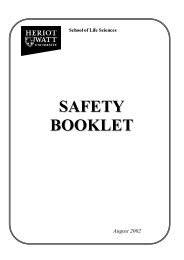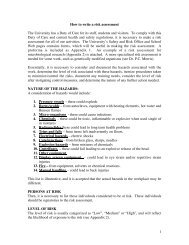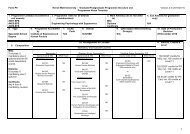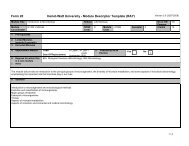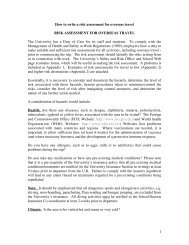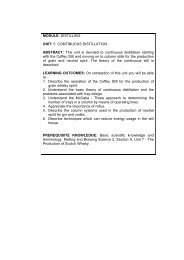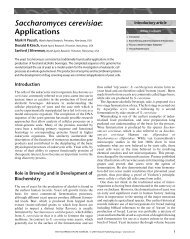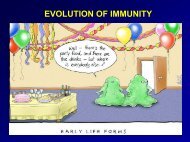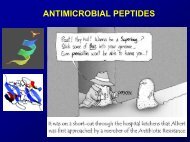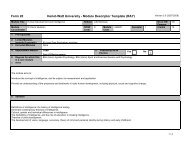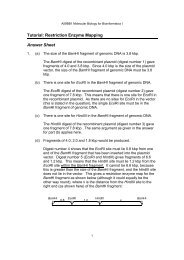Chapter 11 Production of Scotch and Irish whiskies: their history and ...
Chapter 11 Production of Scotch and Irish whiskies: their history and ...
Chapter 11 Production of Scotch and Irish whiskies: their history and ...
Create successful ePaper yourself
Turn your PDF publications into a flip-book with our unique Google optimized e-Paper software.
<strong>Production</strong> <strong>of</strong> <strong>Scotch</strong> <strong>and</strong> <strong>Irish</strong> <strong>whiskies</strong>: <strong>their</strong> <strong>history</strong> <strong>and</strong> evolution 141distilleries in Scotl<strong>and</strong>, 95 are highl<strong>and</strong> malt whiskydistilleries. Of these, no fewer than 49 are situatedin an area measuring 50 miles east to west <strong>and</strong>20 miles southwards from the Moray Firth. Thisarea <strong>of</strong> Speyside has been called the ‘Kingdom<strong>of</strong> Malt Whisky’ (Cameron Taylor, 1970).Classification <strong>of</strong> the four <strong>whiskies</strong> distilled on theisl<strong>and</strong>s <strong>of</strong> Jura, Orkney <strong>and</strong> Skye is disputed.Some authorities list them along with the Islay<strong>whiskies</strong> as ‘isl<strong>and</strong>’ <strong>whiskies</strong>, others as highl<strong>and</strong><strong>whiskies</strong>, which is geographically correct. Thereare also eight grain whisky distilleries in Scotl<strong>and</strong>.Whiskey distilling in Irel<strong>and</strong> was, as has beennoted, first recorded in the 12th century. By 1556,it had become sufficiently widespread to warrantlegislation to control it. A statute proclaimed thatyear stated that a license was required tomanufacture the spirit, but that peers, gentlemenowning property worth £10 or more <strong>and</strong>borough freemen were exempt (McGuire,1973). Taxation <strong>of</strong> whisky distilling graduallybecame more excessive <strong>and</strong> collection <strong>of</strong> taxesbecame increasingly efficient. However, in 1779there was an important change in the distillerylaws. An attempt was made to limit the extent <strong>of</strong>evasion <strong>of</strong> spirit duty by prescribing a minimumrevenue to be exacted from the owner <strong>of</strong> eachstill. The effect <strong>of</strong> this legislation was dramatic. In1779, there was said to be 1,152 registered stillsin Irel<strong>and</strong>. By 1790, this number had fallen to 216<strong>and</strong> this inevitably fostered widespread illicitdistilling (McGuire, 1973). This legislation lasteduntil 1823 when it was replaced by laws that taxed<strong>Irish</strong> whiskey on the volume <strong>of</strong> production,legislation that is essentially still in force today.Development <strong>of</strong> the <strong>Irish</strong> whiskey distillingindustry in the present century has inevitably beeninfluenced by economic circumstances <strong>and</strong> bythe political division <strong>of</strong> Irel<strong>and</strong> into the Republic<strong>and</strong> Northern Irel<strong>and</strong> that occurred in 1922.Barnard (1887) described visits to 28 distilleriesin Irel<strong>and</strong>, but closures <strong>and</strong> amalgamationsfollowed such that when McGuire (1973)prepared his account, there were only twowhiskey-distilling companies in Irel<strong>and</strong>, one withdistilleries in Dublin <strong>and</strong> Cork in the Republic <strong>and</strong>the other with plants in Bushmills <strong>and</strong> Colerainein Northern Irel<strong>and</strong>. These two companies havesince amalgamated <strong>and</strong> have concentrated <strong>their</strong>distillery operations in Cork <strong>and</strong> Bushmills. Therehas also been a move towards production <strong>of</strong> alighter <strong>Scotch</strong>-type whisky in Irel<strong>and</strong> to replacethe heavier traditional <strong>Irish</strong> whiskey.Outline <strong>of</strong> whisky productionprocessesWhiskies differ basically in the nature <strong>and</strong>proportion <strong>of</strong> the cereals used as raw materials<strong>and</strong> on the type <strong>of</strong> still used in the distillationprocess. These differences in the productionprocess are illustrated in the flow diagram inFigure 2 for production <strong>of</strong> <strong>Scotch</strong> malt whisky(production <strong>of</strong> <strong>Irish</strong> whiskey is very similar).Detailed accounts <strong>of</strong> each <strong>of</strong> the unit processesin whisky production are given in subsequentsections <strong>of</strong> this chapter.A characteristic <strong>of</strong> <strong>Scotch</strong> malt whisky is thatthe only cereal used in its manufacture is maltedbarley (Table 1). After milling, the meal is mashedin a mash tun (Figure 2) similar to that used inbreweries for beer production. During mashingor conversion, enzymes in the malt catalyze thehydrolysis <strong>of</strong> starch into fermentable sugars. Inthe manufacture <strong>of</strong> <strong>Scotch</strong> grain whisky <strong>and</strong> <strong>Irish</strong>whiskey, other cereals are used along withmalted barley to provide additional starch in themash tun (Table 1). Owing to the highgelatinization temperature <strong>of</strong> <strong>their</strong> starches,unmalted cereals must be precooked beforethey are incorporated into the mash.The wort, or clear mash, leaving the mashtun is cooled <strong>and</strong> fed into a vessel where it ismixed with yeast. In Scotl<strong>and</strong> <strong>and</strong> Irel<strong>and</strong> thesefermentation vessels have a relatively smallcapacity <strong>and</strong> are known as ‘washbacks’ (Figure2).Fermentation is conducted with strains <strong>of</strong> theyeast Saccharomyces cerevisiae that are usuallyspecially propagated for the purpose, although<strong>Scotch</strong> malt whisky distillers may use somesurplus brewers yeast (Table 1). The process isallowed to proceed to a point at which the



